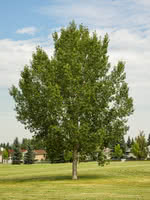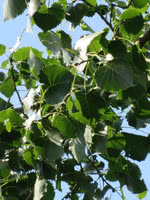Mon-Fri 9am - 5pm Mountain time
Northwest Poplar vs Eastern Cottonwood
Populus x jackii Northwest
Populus deltoides
NOT AVAILABLE THIS SEASON - MIGHT RETURN
Northwest Poplar is a large and fast-growing tree. Due to its wide spread, this tree makes a great shade or shelterbelt tree. Northwest Poplar tolerates partial shade, drought, and most types of soil. This poplar produces no fuzz.
Northwest Poplar continues to be popular as a shelterbelt species due to the great cost savings that come from the wide spread of the branches. It is a staff favorite because of the wonderful shade it provides all summer long.
This fast and tall growing tree has an open, spreading crown and is more suited to waterside planting than other aspens and poplars.
Commonly found in floodplains, stream valleys and lake shores, this tree quickly fills in reclamation areas.
In order to reproduce and grow effectively, Eastern Cottonwood relies on the natural flooding cycle to ensure they are not out-competed by weeds and other plants.
Northwest Poplar Quick Facts
Eastern Cottonwood Quick Facts
In row spacing: 2.4 - 3 m (8 - 10 ft)

